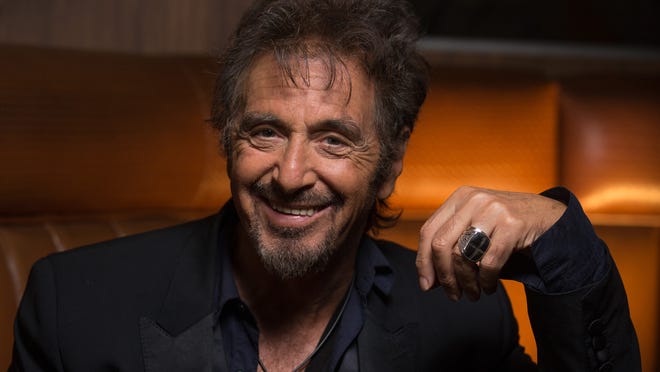Al Pacino is calling upon you to do a service: Watch the newly re-edited version of 1990’s “Godfather Part III,” which director and co-screenwriter Francis Ford-Coppola has renamed “Mario Puzo’s The Godfather, Coda: The Death of Michael Corleone” (limited release now in theaters, available on Blu-Ray Dec. 8).
But Pacino, 80, wants to make clear that he’s speaking “in a way, representing Michael Corleone,” the famed protagonist he portrayed in three cultural-landmark films, including “The Godfather” and “The Godfather Part II.”
“Otherwise it becomes this thing where I’m doing a critique of a film I’m in,” says Pacino in gregarious tone. “This way it would be, how I see the film through Michael’s eyes.”
Pacino made this request twice in a lengthy phone conversation from his Los Angeles home, where he discussed his lack of surprise about Coppola being pulled back into the project three decades later.

“Francis has always been experimental. And directors do that a lot. But this far along, it’s very unusual,” Pacino says. “It didn’t require any new filming. He took what he had, marinated on it, and switched things around. I thought he did it rather cleverly.”
The actor sees the new beginning as key, Rather than a moody view of Corleone’s Lake Tahoe, Nevada, home, the action begins at a Vatican business meeting. Pacino, 52 at the time of the film’s release, wore makeup to play an aged Michael in his 60s. “Godfather, Coda” opens as he negotiates a multimillion-dollar deal with the Vatican Bank and a nervous Archbishop Gilday (Donal Donnelly).
“This alters things to such a degree,” says Pacino. “The axis of the film changes to where it belongs. Because the thing that drives Michael is the need to escape the world that he inherited. This breakaway is the theme for Michael.”
The consuming guilt alluded to in the original opening sequence, after brother Fredo was killed on Michael’s orders in “Godfather II,” still seeps out in the final chapter.
“The guilt is so buried,” says Pacino. “He’s justified everything, and instinctively he just keeps going. Somehow. It’s weird. He carries the destruction that has been a part of him and his life. But mainly, his brother, it was deep down. That was really the end for him.”
Michael’s onetime struggling, immigrant father Vito (primarily portrayed by Marlon Brando and Robert De Niro in the films) was more suited to handle the guilt that came with running the crime family. “Michael was privileged as a child and didn’t understand these kinds of machinations,” says Pacino.

Grown daughter Mary is the ultimate innocent victim of this world, After Winona Ryder withdrew from the film, Coppola’s brought in his daughter Sofia, a newcomer. Critics were harsh about the 19-year-old’s performance. Pacino says the new version highlights how Coppola wanted “the innocence and the awkwardness of this young girl” and a “not-quite-formed human being” to make the tragedy more poignant and the forbidden love story with young gangster Vincent (Andy Garcia) more palpable.
“When that love happens, you know it,” says Pacino. “I have two daughters, It’s a very interesting thing when you see it,”
The new title and re-editing emphasizes the impact of doomed Mary’s death. “The Death of Michael Corleone” was the title Coppola always wanted, but he was turned down by Paramount Studios. Pacino believes the change from “Godfather III” frees it from the other two landmark films, after it received mixed critical reviews.
“Godfather I and II sort of belong in the same extension,” Pacino says. While the third, by virtue of story themes, is in its own category. “It’s the final chapter. But it’s just a different kind of film.”

The new ending
With the new edit, the emphasis of “Godfather, Coda” is on Corleone’s emotional death, when Mary collapses on the opera steps after taking the bullet that was meant for her father. The original’s final scene, showing the wheelchair-bound Michael, years later, slumping to his death, has been cut. Now Michael stares out from his chair, a broken man.
“The death is a metaphor, because in the film, he doesn’t die, It’s the death of an idea, of a trajectory and of course the ultimate for him is the loss of his daughter. It’s a price that he would’ve paid for gladly with his life,” says Pacino. “It’s very sad.”
Pacino waxes humorously about his excised death scene, complete with a tricky fall to the ground from a wheelchair. “It took days to just try to figure that out. I really wanted that! You know how actors are with death scenes, always looking for a death scene that hasn’t been done before. And invariably, they always do it the way it’s (been) done forever,” he says.
The actor saw the newly edited film with co-stars Talia Shire, George Hamilton and Diane Keaton (his onscreen ex-wife and one-time girlfriend) at a recent screening on the Paramount lot. It was an emotional viewing, but Pacino has trouble separating that reunion from the actual film.
“It was more moving. I could feel that from the others. There’s an impact that the film has,” he says. “I’m not sure if it’s just because it’s a film we made 30 years ago, being redone and presented as new, or if the changes made it more emotional. But the tragedy shows itself a little more completely in this version. And it is a tragedy.”
